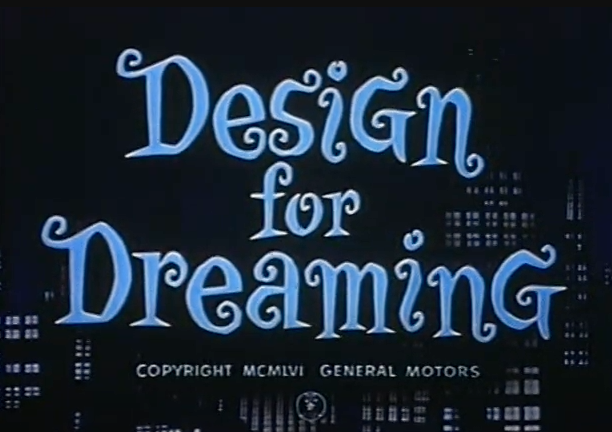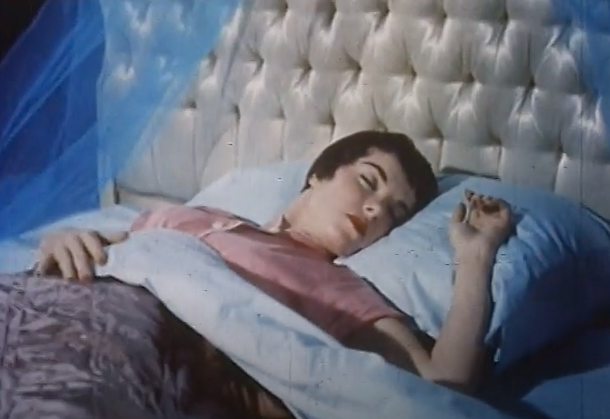By Eric J. Savitz, editor-in-chief, GM News
By Eric J. Savitz, editor-in-chief, GM News
Welcome to opening night for GM Theater, a new feature on GM News highlighting the amazing cinematic treasure trove of the General Motors Heritage Center and Archives.
We’ve been dipping into the Heritage archives for our ongoing Retro Rides series about interesting vehicles from GM’s rich history, like the GMC Motorhome, the GM Futurliner, and the Jimmy Deuce-and-a-Half. One thing we’ve discovered in the process is that the company over the last century has produced an astonishing variety of unusual and oddly compelling films that are worth rediscovering.
GM Theater’s first pick is the 1956 classic “Design for Dreaming,” a roughly 9-minute film created for GM by a small, defunct advertising firm called MPO Productions. Design for Dreaming was produced in connection with that year’s edition of Motorama, a travelling car expo General Motors held periodically from 1949 to 1961. This was no obscure event: The 1956 edition of the show attracted more than 2 million people to stops in New York City (at the Waldorf Astoria, no less), Miami, Los Angeles, San Francisco, and Boston, and featured a wide variety of both current year models and concept cars from all of GM’s major brands. Moving the exhibits around the country required a caravan of 125 trucks.
Caption: The dancer Tad Tadlock, in "Design for Dreaming."
“Design for Dreaming” is staged as a sort of magical industrial ballet, in which a woman (the late dancer and choreographer Thelma “Tad” Tadlock) is awakened in her bedroom by a mysterious masked figure in a top hat and tails (the late Hollywood and Broadway choreographer Marc Breaux), who lures her to wake from her slumbers to visit Motorama at the Waldorf, where she gets a tour of the show’s coolest cars from her handsome suitor.
“I want a Corvette,” she sings operatically while twirling and literally floating around the show with her Prince Charming. “I want a Pontiac, too!” Oldsmobile, Buick, and Cadillac also get call outs, before she’s whisked off for a spin around a kitchen filled with space-age appliances from Frigidaire, then a GM subsidiary. The two of them finish their adventure with a ride down the “highway of tomorrow” in the turbine-powered Firebird II concept car.
Now in the public domain, clips from “Design for Dreaming” have been used in many films and music videos, including a featured appearance in a 1994 episode of Mystery Science Theater 3000, the cultish TV show in which various old and obscure films were mocked mercilessly by host Joel Hodgson and his robot sidekicks. Peter Gabriel and Rush both used clips from the film in music videos; bits of the film show up in the opening credits for both “The Hills Have Eyes,” from 2006, and the 2004 version of “The Stepford Wives,” among other places.
The bottom line is that “Design for Dreaming” is a classic. Give it a watch.

Welcome to opening night for GM Theater, a new feature on GM News highlighting the amazing cinematic treasure trove of the General Motors Heritage Center and Archives.
We’ve been dipping into the Heritage archives for our ongoing Retro Rides series about interesting vehicles from GM’s rich history, like the GMC Motorhome, the GM Futurliner, and the Jimmy Deuce-and-a-Half. One thing we’ve discovered in the process is that the company over the last century has produced an astonishing variety of unusual and oddly compelling films that are worth rediscovering.
GM Theater’s first pick is the 1956 classic “Design for Dreaming,” a roughly 9-minute film created for GM by a small, defunct advertising firm called MPO Productions. Design for Dreaming was produced in connection with that year’s edition of Motorama, a travelling car expo General Motors held periodically from 1949 to 1961. This was no obscure event: The 1956 edition of the show attracted more than 2 million people to stops in New York City (at the Waldorf Astoria, no less), Miami, Los Angeles, San Francisco, and Boston, and featured a wide variety of both current year models and concept cars from all of GM’s major brands. Moving the exhibits around the country required a caravan of 125 trucks.

“Design for Dreaming” is staged as a sort of magical industrial ballet, in which a woman (the late dancer and choreographer Thelma “Tad” Tadlock) is awakened in her bedroom by a mysterious masked figure in a top hat and tails (the late Hollywood and Broadway choreographer Marc Breaux), who lures her to wake from her slumbers to visit Motorama at the Waldorf, where she gets a tour of the show’s coolest cars from her handsome suitor.
“I want a Corvette,” she sings operatically while twirling and literally floating around the show with her Prince Charming. “I want a Pontiac, too!” Oldsmobile, Buick, and Cadillac also get call outs, before she’s whisked off for a spin around a kitchen filled with space-age appliances from Frigidaire, then a GM subsidiary. The two of them finish their adventure with a ride down the “highway of tomorrow” in the turbine-powered Firebird II concept car.
Now in the public domain, clips from “Design for Dreaming” have been used in many films and music videos, including a featured appearance in a 1994 episode of Mystery Science Theater 3000, the cultish TV show in which various old and obscure films were mocked mercilessly by host Joel Hodgson and his robot sidekicks. Peter Gabriel and Rush both used clips from the film in music videos; bits of the film show up in the opening credits for both “The Hills Have Eyes,” from 2006, and the 2004 version of “The Stepford Wives,” among other places.
The bottom line is that “Design for Dreaming” is a classic. Give it a watch.